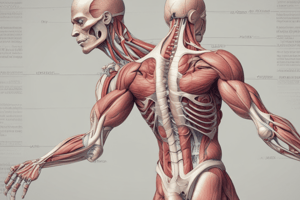Podcast
Questions and Answers
Which muscle is only present in equines and is responsible for flexion of the hip and abduction of the pelvic limb?
Which muscle is only present in equines and is responsible for flexion of the hip and abduction of the pelvic limb?
- Gluteus superficialis (correct)
- Semimembranosus
- Gluteus medius
- Gluteus profundus
Which muscle is responsible for flexing the hip joint and extending the stifle joint?
Which muscle is responsible for flexing the hip joint and extending the stifle joint?
- Gluteus superficialis
- Tensor fasciae latae (correct)
- Gluteus medius
- Biceps femoris
Which muscle originates from the ischiatic spine and inserts into the greater trochanter of the femur, with the action of abducting the pelvic limb?
Which muscle originates from the ischiatic spine and inserts into the greater trochanter of the femur, with the action of abducting the pelvic limb?
- Gluteus medius
- Gluteus profundus (correct)
- Tensor fasciae latae
- Gluteus superficialis
Which muscle originates from the sacroiliac ligament and ischiatic tuber, with an action of extending the limb in general?
Which muscle originates from the sacroiliac ligament and ischiatic tuber, with an action of extending the limb in general?
Which muscle originates from the transverse process of first and second caudal vertebrae and ventral surface of ischiatic tuberosity, with an action of extending the hip joint and hock joint, and flexing the stifle joint?
Which muscle originates from the transverse process of first and second caudal vertebrae and ventral surface of ischiatic tuberosity, with an action of extending the hip joint and hock joint, and flexing the stifle joint?
Study Notes
Equine Muscles
- The tensor fasciae latae muscle is only present in equines and is responsible for flexion of the hip and abduction of the pelvic limb.
Muscle Actions
- The iliopsoas muscle is responsible for flexing the hip joint and extending the stifle joint.
Muscle Origins and Actions
- The gluteus medius muscle originates from the ischiatic spine and inserts into the greater trochanter of the femur, with the action of abducting the pelvic limb.
- The gluteus maximus muscle originates from the sacroiliac ligament and ischiatic tuber, with an action of extending the limb in general.
- The caudofemoralis muscle originates from the transverse process of first and second caudal vertebrae and ventral surface of ischiatic tuberosity, with an action of extending the hip joint and hock joint, and flexing the stifle joint.
Studying That Suits You
Use AI to generate personalized quizzes and flashcards to suit your learning preferences.
Description
Test your knowledge about the lateral muscles of the hip and thigh with this quiz. Identify the origins, insertions, and functions of muscles like the tensor fasciae latae, gluteus superficialis, and gluteus medius.




